Abstract
Residential mobility serves as a pivotal determinant in reshaping urban social spaces and driving spatial differentiation and segregation within cities. This study harnesses a rich dataset from surveys and the housing market in Nanjing, China to dissect the spatial distribution patterns of its mobile population. Employing the Mantel Test—a novel approach in this context—we assess the interplay between spatial shifts in residential locations and the socio-demographic attributes of individuals, thereby shedding light on the socio-spatial dynamics across various migration categories. Our findings underscore a pronounced trend in the post-2000 era of China’s housing marketization: residential migrations occur predominantly within a five-year cycle. The decay in migration distances aligns with the migration field formula, suggesting a systematic attenuation of mobility over spatial extents. The study identifies a strong congruence between the mobility rings—zones of frequent residential movement—and the micro-level characteristics of residents, reflecting the nuanced fabric of urban stratification. Furthermore, we unveil how macro-level institutional frameworks and the housing market milieu substantially shape and limit the migration frequency, hinting at the overarching impact of policy and economic landscapes on residential mobility patterns. The paper culminates by articulating the underlying dynamics of urban residential migration, providing a comprehensive account that contributes to the discourse on sustainable urban development and planning.
1. Introduction
Residential mobility refers to the relocation of individuals or households from one place to another, also understood as a process of housing reselection [1]. This encompasses both inter-city and intra-city moves. In the initial phases of urban development, shifts in urban populations primarily entailed the influx of populations from non-urbanized areas into urban regions. Upon reaching a certain developmental stage, intra-city mobility becomes the predominant form. As labor mobility increases, residential movements and relocations have evolved into increasingly prevalent phenomena of global socio-economic significance. The British Household Panel Survey (BHPS) indicates that approximately 8% of UK households relocate annually [2]. The annual migration rate for the U.S. population is estimated at around 15–17% [3]. After housing reforms in the late 1990s, China also witnessed a rapid surge in residential mobility rates. Research by Li and Mao demonstrated that, between 2000 and 2012, the annual residential mobility rate in Guangzhou, a major city in southern China, stood at about 10% [4]. Temporal–spatial features, operative mechanisms, and socio-spatial implications of mobility can vary significantly across countries, regions, and cultural terrains, and even within a city across different periods or developmental stages. China’s housing system, household housing consumption, and processes of urban spatial restructuring differ notably from fully marketized North American countries and Western European nations with greater governmental intervention [5,6]. Particularly for contemporary major Chinese cities, urban residential mobility in the new era of China exhibits increased comparability with Western cities [7,8].
Since China’s reform and opening-up, its cities have undergone three major waves of internal mobility. Firstly, in 1978, the dissolution of large unit compounds resulted in massive involuntary relocations. Secondly, the relaxation of the household registration system in 1984 allowed rural residents to move to urban areas, initiating a transformation of urban–rural resident identities and urban residential mobility. This era also marked the beginning of the housing market’s filtration towards the lower-income groups [9]. Thirdly, the emergence of the real estate market in 1998, accompanied by rapid globalization and urbanization, led to both voluntary and involuntary urban relocations. In the 21st century, especially in China’s major cities, the mode of urban development is transitioning from external expansion to internal restructuring. The intensified activities of new city construction and urban renewal have led to more pronounced differentiation in urban living spaces. Concurrently, with the deepening reform of the housing market, mobility influenced by non-market factors has decreased [10]. In a context where housing price growth catalyzes housing asset disparities, such differences have become significant indicators of urban wealth disparities [11,12]. This has fostered class consciousness and cultural identity based on housing attributes [13,14]. Accompanying this dual differentiation of urban residential spaces and housing classes, urban residents are now relocating on unprecedented scales and frequencies [15,16], potentially heralding the fourth wave of internal mobility since the onset of the reform era. In an era marked by increasingly refined social stratifications and where residential choices are predominantly guided by family preferences [17,18], it becomes imperative to decipher the temporal–spatial characteristics, general patterns, and critical factors of mobility behaviors, exploring the evolution and future trends of urban spatial structures from a residential mobility perspective.
Rossi’s 1955 publication [19], “Why Families Move”, significantly stimulated scholarly contemplation on mobility, marking the onset of mobility studies. Subsequent research delved into various aspects of mobility, including the desire to move, patterns of differentiation [20,21], underlying mechanisms [22,23,24], effects [25], and influential factors [26,27,28]. Exchange theories by Alonso, “push-threshold” theories, intervention opportunity models, and gravity models, as well as numerous mathematical statistical and spatial analysis methods, have been extensively utilized [29,30,31,32,33,34,35]. In these studies on mobility, the clustering characteristics of residential mobility are often interpreted as a spatial projection of the social structure within cities. For instance, in research related to residential segregation, the clustering features of different groups are understood as the spatial segregation of various social classes or races within urban spaces [2,36]. In contrast, non-clustered mobility is typically explained as a rational choice driven by similar factors. These driving factors often include family dynamics, individual life cycles, income levels, housing consumption, and children’s education [37]. Overall, the former is usually studied using census data, while the latter tends to be researched using more micro-level survey data. While census data is reliable, the characteristics of large-scale population movements can overshadow heterogeneity within regions, resulting in the absence of micro-level patterns. In fact, obtaining residential mobility data through official channels is challenging worldwide, with only a few exceptions like the Netherlands [38].
Although micro-survey data can reveal more detailed reasons for urban residents’ mobility, such studies are typically focused on a specific group or a particular community. This limitation is partly due to the difficulty of conducting surveys on residential mobility at the urban scale, but primarily it stems from methodological constraints. Questionnaire data are often analyzed using event history methods, binary/multinomial logistics, structural equation modeling, and other techniques to explore the process and reasons for relocation. However, these methods generally struggle to describe the different spatial characteristics of group mobility, such as the mobility rings, distance, and frequency. These three spatial elements, crucial in mobility research, are challenging to analyze within the same model or study. As a result, the challenge lies in holistically considering both the socio-demographic attributes and spatial characteristics and lucidly depicting their interrelationship.
Insights from Mantel Test analysis are illuminating in this regard. The Mantel test method is predominantly utilized in ecology and biogeography to analyze the relationship between species distribution and environmental factors, or the correlation between genetic distance and geographical distance among different species or groups [39,40]. In recent years, other research initiatives employing Geographic Information Systems (GISs) have also begun to experiment with this method [41,42]. For example, in environmental science, the Mantel test is used to assess the correlation between environmental factors, such as climate and soil type, and species distribution [43]. In epidemiology, it is applied to analyze the relationship between the spatial distribution of disease incidence and environmental or demographic factors [44]. In archaeology, the method is utilized to study the spatial relationships between cultural heritage sites or archaeological findings [45].
The widespread use of the Mantel Test in these disciplines is attributed to its capability to simultaneously explore correlations between multidimensional datasets or multiple variables. It yields a correlation coefficient (Mantel’s r) alongside a p-value to assess the association between two matrices, offering results that are both interpretable and comprehensible. Thus, the spatial characteristics of residential mobility can be structured into one data matrix, while individual socio-demographic features of residents can be fashioned into another. Utilizing the Mantel Test, one can deduce the correlation between individual socio-demographic characteristics and mobility spatial traits (such as mobility rings, distance, and frequency). Such an approach not only gives due weight to both socio-demographic attributes and spatial characteristics but also lucidly showcases their relationship. This facilitates a more comprehensive grasp of mobility phenomena, proffering valuable insights for urban planning and community development.
The subsequent arrangement of the paper is as follows: Section 2 introduces the study area and research methods employed in this research. Section 3 conducts a statistical analysis of the survey data focusing on mobility frequency, distance, and direction, establishing the spatial characteristics of urban residents’ mobility for the subsequent Mantel test analysis. Section 4 presents the results of the Mantel test analysis and summarizes the driving mechanisms of urban residents’ mobility. The paper concludes with the Section 5.
2. Materials and Methods
2.1. Research Area and Data
Nanjing, situated in the economically prosperous Yangtze River Delta region, serves as a quintessential representation of China’s emerging first-tier cities. The city exhibits vibrant internal population mobility. Results from the Seventh National Population Census indicate that there are 1.757 million people in Nanjing experiencing a separation of households and residents, accounting for 40% of such a population. Concurrently, the urban areas of Nanjing are highly urbanized, with its housing prices ranking eighth nationwide and third among the emerging first-tier cities. This has resulted in pronounced housing differentiation within the city. Given these characteristics, this study has chosen Nanjing as its research subject due to its representative nature. To ensure spatial continuity of the research units, the city is segmented into four spatial rings: the area within the Ming Dynasty city wall is defined as the inner city, the region between the Ming city wall and the ring road as the core city (excluding the inner city), and the combination of the southern and northern primary urban areas is designated as the main city (excluding the core city). The remaining 11 districts outside the primary city are also considered (as shown in Figure 1).
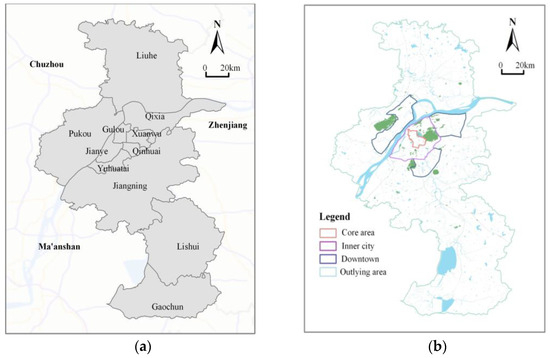
Figure 1.
Research area: (a) Distribution of Nanjing; (b) Four spatial rings.
This study employs primary data from a large-scale urban survey questionnaire (the group, composed of experts and scholars from 10 research institutes in Nanjing, combined with the “Questionnaire Star” survey platform “www.wjx.cn (accessed on 1 May 2020)”, conducted a questionnaire survey in May–August 2020 within the city of Nanjing, targeting residents with fixed residences, and adopting the methods of random interview, regional sampling, microblog posting, and online filling). The survey encompasses information regarding residents’ sociodemographic attributes, household attributes, economic attributes, housing characteristics, and household mobility patterns between 1980 and 2020. In total, more than 5000 questionnaires were distributed, from which 4015 complete and valid responses were obtained, encompassing 13,520 individuals. This represents approximately 0.145% of Nanjing’s permanent urban population. As depicted in Table 1, the spatial distribution and structural characteristics of the sample align closely with the overall situation of the city. Notably, respondents are predominantly concentrated in urban districts such as Jiangning, Gulou, Qinhuai, and Qixia, with a significant representation of individuals possessing higher education degrees and belonging to the middle-aged and younger cohorts. Conversely, elderly individuals and those with education levels below junior high school are underrepresented in the sample.

Table 1.
Spatial distribution and structural characteristics of questionnaire samples.
2.2. Methods
Mobility represents an investment in social and human capital and is also the outcome of individual and familial decisions aimed at maximizing overall benefits under various housing policies and market conditions. Building on the previously analyzed spatial characteristics of mobility, this study conducts a questionnaire survey of residents with fixed residences in Nanjing, focusing on household residential mobility patterns from 1980 to 2020. Employing the Mantel Test, this research probes into the correlation between life-course indicators, household characteristic indicators, housing market factors, macro-institutional factors, and the mobility rings, mobility distance, and frequency of mobility by residents.
In terms of variable selection, this paper emphasizes attributes related to an individual’s life course, household features, macro-institutional elements, and housing characteristics. Specifically, for life-course attributes, four indicators are chosen: gender, educational level, occupation, and age. Household characteristic attributes include six indicators: family size, inter-generational population, annual family income, per capita housing area, number of private vehicles, and quantity of housing units. Two indicators are selected for macro-institutional attributes: mobility era and household registration nature (hukou). For the housing market attributes, four indicators are adopted: housing nature, era of housing construction, housing ownership, and housing prices. In total, 16 explanatory variables were derived. The assignment of values to the relevant variables can be found in Table 2.

Table 2.
Description of variables and descriptive statistics.
2.2.1. Mantel Test
The Mantel test was proposed by Nathan Mantel in 1967 [46]. This method of correlation analysis based on distance matrices is widely utilized in the field of ecology. While standard correlation analyses can only manage two or more variable elements, the Mantel test assesses the correlation between two data matrices. The underlying principle starts with the assumption that the two data matrices are uncorrelated. The correlation between the matrices is then evaluated by examining if the sample distances within the matrices are related. If the resulting p-value is significant, it indicates a correlation. Moreover, a larger r-value suggests a stronger correlation. In this study, we employed the Mantel test based on the R programming language to detect the correlation between the urban middle-class household mobility attribute matrix (X) and the social attribute matrix (Y).
As presented in Table 2, the attributes matrix of household mobility (X) primarily encompasses three aspects: mobility rings, mobility distance, and mobility frequency. The social attribute matrix (Y) includes the characteristics of life course, household characteristic, macro-institutional factors, and housing market factors. Utilizing the Mantel Test method, it is possible not only to display the correlations between each indicator of household relocation attributes and social attributes but also to further explore the interrelations among the various indicators within social attributes. Based on this, a more comprehensive set of influencing factors for urban residents’ relocation is presented, thereby exploring the dynamics behind the residential migration of urban residents.
This serves as the critical basis for extracting residential mobility patterns. The formula for the normalized Mantel test statistic r is as follows.
wherein represent the elements in matrices X and Y, respectively, with i ≠ j; n is the number of distances in one of the matrices (excluding the diagonal), and are the means of X and Y, respectively; and are the standard deviations of X and Y, respectively.
2.2.2. Multinomial Logistic Regression Model
The multinomial logistic regression model is a variant of the logistic regression model, employed to elucidate the linear relationship between the logarithmic function of a dependent variable and multiple independent variables. Multinomial logistic regression analysis stands as one of the most extensively applied methods within the ambit of multivariate statistical analysis. It can be perceived as a conjoint estimation of several binary logistic models, each constructed via pairwise pairing of the choice behaviors within the dependent variable. By establishing a mathematical model between the variables and the explanatory variables, the constructed model is subjected to validation. When conforming to stipulated conditions, values of the given explanatory variables are input into the regression model to, thereby, compute future predictive values for the variable. The specific model configuration is as follows:
In the formula, represents the log-odds ratio, where is the selected reference category, and is the total number of categories included in the categorical variable. In this paper, takes on the values 0, 1, and 2; is the dataset of vectors , and the vector represents the partial regression coefficients corresponding to : , , …, . When , the left side of the equation equals ; thus, , meaning that the log-odds of a particular choice relative to itself is 0, leading to the coefficients of any explanatory variables corresponding to that category necessarily being 0 as well. By solving for equations, the predicted probabilities for each choice can be obtained:
3. Spatial and Temporal Characteristics of Nanjing Residents’ Mobility
3.1. Frequency of Mobility
In this study, frequency of mobility is determined using the ratio of the duration of residence to the number of moves, indicating how often a move occurs in a given number of years. As illustrated in Figure 2, among the resident population that has never relocated, the largest proportion (51.83%) falls within the period of 2011–2020. For those who move less than once every five years, nearly 90% of the population moved during 2001–2010 and 2011–2020, with the 2001–2010 period having the highest proportion at 52.9%. Among those who move once every 5–10 years and those who move less frequently than once every 10 years, residents who moved before 2000 dominate the population. There were no residents in the 2011–2020 period who had a relocation frequency of less than once every 10 years. Overall, residents who move less than once every five years and those who have never relocated rank first and second, respectively, in mobility frequency. Comparatively, residents who moved to Nanjing after 2000 tend to relocate more frequently.
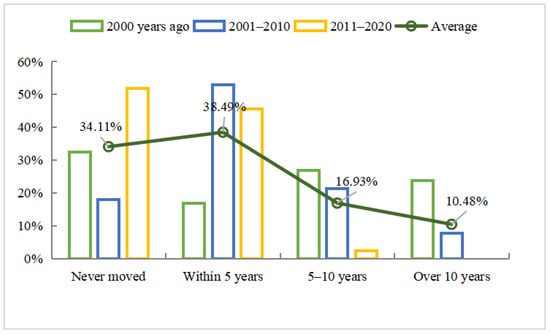
Figure 2.
Change in frequency of mobility, 1980–2020.
3.2. Mobility Distance
Mobility distance involves the latitude and longitude of both the starting and ending points (Figure 3a). Out of the 4015 family samples in Nanjing, those that have not relocated and those with obviously incorrect relocation addresses were excluded, leaving 2540 questionnaires for quantitative analysis in this study. To understand mobility distance, we begin by examining the number of relocations from specific distance zones. For a given destination, such as a point receiving migrants, we can graph the number of relocations based on the distance from various origins to this area. The data on mobility distance fits well with the urban relocation field formula (the urban migration field is defined as the area that receives the main migration flows from a place or conveys them to the main area of this city, y = ax−b: y = number of migrants from the place of origin to the place of destination, x = distance from the place of origin to the place of destination, a = intercept of y, and b = slope of the distance decay curve) y = ax−b, with a fit curve R2 value of 0.97 [47] (Figure 3b). Within the 0–10 km range, the relocation rate of urban residents drops from 36.45% to 12.15%. As the mobility distance increases, the number of relocating residents decreases significantly. In the 20–30 km range, the urban relocation rate is concentrated between 1% and 5%, with a slowly declining trend. Beyond 30 km, the relocation rate for urban residents is extremely low, consistently below 1%, indicating virtually no resident relocations.
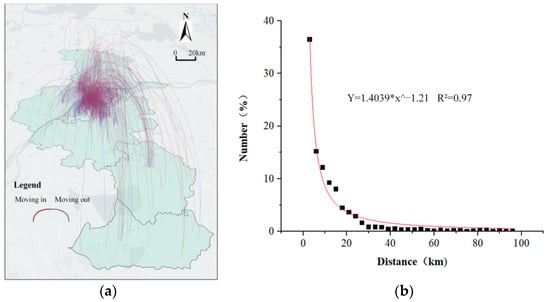
Figure 3.
Mobility distance: (a) Sample mobility distances; (b) Fitting of mobility distance data to urban migration field equations.
3.3. Mobility Direction
From the perspective of mobility direction, intra-district (Figure 4a) or within-spatial-ring (Figure 4b) mobility predominate. Over 50% of mobility occurs within administrative districts, with peripheral suburban areas like Lishui County and Liuhe District reaching as high as 74.60% and 68.75%, respectively. Even for mobility crossing district boundaries, they mainly occur towards adjacent districts. For instance, 9.97% of migrants from Xuanwu District move to Gulou District, and 11.48% from Jianye District relocate to Gulou District. A similar trend is evident in intra-ring mobility; for instance, 60.29% and 79.42% of mobility within the inner city and core ring, respectively, happen within the same spatial ring. Overall, there is an increase in the number of residents migrating to the core area, with a slight decline in the inner city and outlying area.

Figure 4.
Mobility direction: (a) Mobility districts of Nanjing; (b) Mobility of four spatial rings.
4. The Patterns and Mechanisms of Residential Mobility
The spatial variation in residential mobility is intrinsically linked to the micro-level individualized needs and choices of families, the characteristics of the housing market, and macro-level institutional factors, hence displaying specific spatial distribution patterns. To further elucidate the mechanisms underlying the spatial characteristics of residential mobility, we regard the socio-economic attributes of residential mobility as a matrix. By successively conducting Mantel Test analyses with mobility rings, mobility frequency, and mobility distance, we can deduce the correlation between residents’ individual social characteristics and spatial changes in mobility (Figure 5).
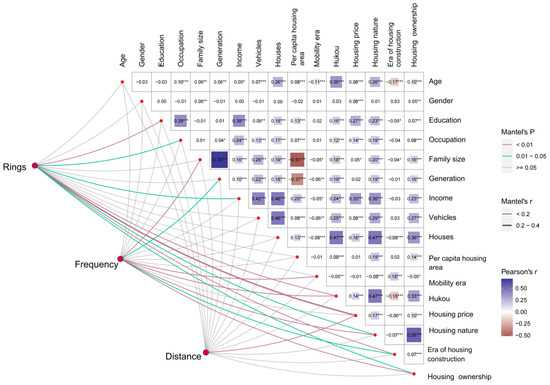
Figure 5.
Correlation matrix between mobility characteristics and individual socioeconomic attributes based on the Mantle test. Note: *** denotes p < 0.001; ** denotes p < 0.01; * denotes p < 0.05.
4.1. Spatial Changes in Mobility
4.1.1. Mobility Rings: Social Differentiation Manifested in Urban Zones
Within the context of life course and familial characteristics, significant disparities are observed within mobility rings based on education levels, occupation, and annual family income. A robust positive correlation exists between education level, occupation, and annual family income. Residents with higher educational attainment possess enhanced competitiveness in the job market, are more likely to secure higher-ranking and formal employment positions, and typically achieve relatively higher and more stable incomes. With the general enhancement in educational levels across society, the educational prerequisites for urban employment have proportionally risen. As illustrated in Figure 6, the core area is predominantly occupied by individuals with tertiary education or higher, managerial personnel in government agencies or state-owned enterprises, and families with an annual income exceeding CNY 400,000. In contrast, outlying areas are largely inhabited by industrial workers with education levels of junior high school or lower and vocational high school. The disparity in family annual income can even reach tenfold.
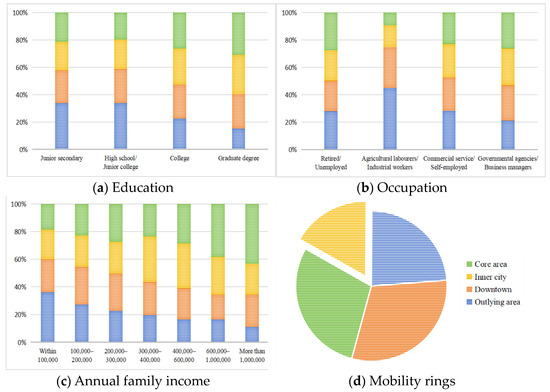
Figure 6.
Migratory rings–life course and family characteristics attributes: (a) Education; (b) Occupation; (c) Annual family income; (d) Mobility rings.
Concerning the macro-institutional attributes and housing market factors, a close relationship is observed between mobility rings, household registration nature (hukou), housing prices, and housing nature. A strong positive correlation is apparent between urban residents possessing Nanjing household registration, housing prices, and housing nature. Within these mobility rings, Nanjing typifies the common urban scenario: the city center typically offers abundant facilities and services, and property prices usually decrease progressively moving outward from the city core. Residents with Nanjing household registration predominantly purchase commercial properties and properties with limited property rights in the inner city and core area, far outstripping those without the city’s registration. In contrast, residents purchasing protected housing or those in resettlement due to redevelopment are primarily located in the downtown and outlying area. Notably, the proportion of residents with Nanjing household registration renting in the core area substantially surpasses that of non-registered residents. Geolocation of these residents reveals their rental neighborhoods are predominantly situated near renowned primary schools such as Lasa Road Primary, Langya Road Primary, and Lixue Primary (Figure 7). The housing nature of these mobility groups primarily shifts to “owning and renting families”. Integrating their educational levels, annual family income, and housing prices, it is discerned that most of these individuals possess at least a bachelors degree, have substantial occupational statuses, and boast high annual family incomes. They typically migrate once every 6.48 years. With the burgeoning emphasis middle-class families place on offspring education, an increasing number of families with school-aged children opt for properties near schools, either “school district housing” or rental properties. This aligns with conventional understanding and mirrors the Jiaoyufication phenomenon identified in empirical studies by scholars such as Wu et al. and Song et al. [48,49].
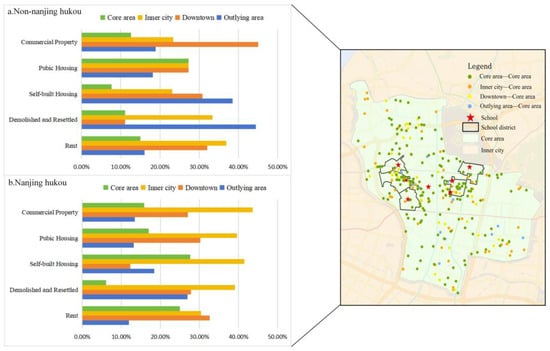
Figure 7.
Rings of mobility under the nature of hukou and housing.
4.1.2. Mobility Distance: Housing Search Driven by House Prices
The mobility distance demonstrates a certain correlation exclusively with housing prices, among which the connection between housing prices and mobility rings is the most pronounced (correlation coefficient r ranging between 0.2 and 0.4). By visualizing housing prices and distance by rings, as shown in Figure 8, within the 0–40,000 currency unit price range, residents of the outlying areas are highly sensitive to housing prices, exhibiting mobility distance variations of nearly 40 km. This equates to housing prices increasing by 1000 currency units for every additional kilometer in distance. This reflects the likelihood of residents in outlying areas choosing longer mobility distances due to their economic constraints. In contrast, for the price range above 40,000 currency units, mobility is concentrated within the core and inner-city rings, with residents having relatively fixed mobility distances. This suggests that, in areas with higher housing prices, residents’ mobility distances are primarily influenced by their personal preferences and living needs, or they might be inclined to remain in familiar communities and environments. They possess greater economic capabilities, allowing them to opt for residences in city centers to take advantage of the facilities and services those areas offer. However, this is merely a general trend. Within the price range exceeding 50,000 currency units per square meter, a minor subset of the downtown exhibits long-distance mobility. By geospatially locating these residents and analyzing their economic attributes, a portion can be identified as the ‘inner-city allure type’ migrating from the outlying area to the downtown, with an average age of 32.7, largely relocating for reasons such as proximity to work, marriage, or children’s education. Another portion represents the ‘pursuit of life quality type’ [50] who migrate from the inner city to suburban spacious residences, primarily residents with expanding family members and housing space demands.
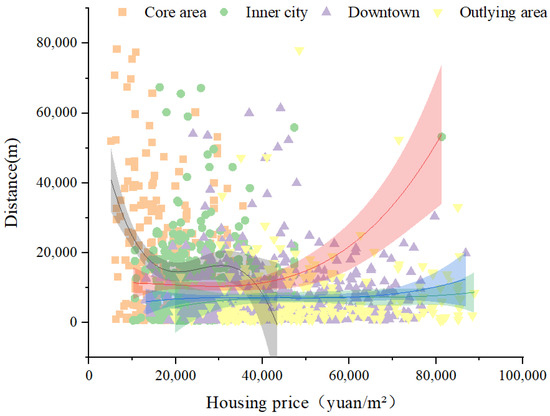
Figure 8.
Relationship between mobility distance and house prices.
4.1.3. Mobility Frequency: Dynamics of Housing Careers
The mobility frequency is significantly associated with family size, inter-generational population, mobility era, household registration nature (hukou), housing nature, and the era of housing construction. Given the characteristic attributes of the variables, the Logistic regression model, which is suitable for handling categorical variables, was employed to further investigate the impact of various factors on mobility frequency. To avoid multicollinearity among independent variables, the variance inflation factor (VIF) was initially used to test for multicollinearity. The inter-generational population was excluded, and the results showed VIF values around 1, indicating no issues of multicollinearity among the variables. The variable assignment details are presented in Table 3. Incorporating the variables into the model, a main effects model was employed for regression analysis, and the computed results are shown in Table 4.

Table 3.
Variable description and descriptive statistics.

Table 4.
Regression of factors affecting mobility frequency.
Firstly, from the perspective of family characteristic indicators, the number of family members has a significant impact on the frequency of high mobility. Specifically, families with fewer members (e.g., single-person households) are more inclined to migrate frequently, with their mobility rate being 1.63 times that of larger families (e.g., three-person households). This suggests that the stability of family structures, a sense of urban belonging, and social security can encourage people to opt for a fixed residence. This observation is consistent with common sense and aligns with the empirical findings of scholars such as Clark, Fang and Zhang, and Bernard [51,52,53].
Secondly, housing market attributes and macro-institutional factors also significantly influence mobility frequency. Different phases of China’s urban housing market reforms, including the phases of housing privatization, industrialization, and financialization, have varying effects on people’s mobility frequency. Compared to the privatization phase (1980–1998), the industrialization phase witnessed an explosive growth in resident mobility, especially among those with a high mobility frequency, reaching a staggering 42.95 times that of the privatization phase. This may be attributed to changes in the allocation of social resources resulting from housing market reforms, the transformation of unit functions, and the dissolution of unit compounds. The “de-marketization” of social resource allocation was further “stripped”, weakening the stability of family housing.
Moreover, changes in housing rights also significantly affect mobility frequency. For instance, families in the rent-to-rent and rent-to-buy categories migrate more frequently than those in the buy-to-buy category, indicating that populations with their own housing are more inclined to stay put. Concurrently, there is a positive correlation between the era of the house and the mobility frequency; populations residing in newer houses tend to move more frequently. Finally, with the deepening of housing reform policies [54] and the relaxation of the hukou system [55], mobility occurrences have become more frequent. However, the impact of hukou status on residential mobility has weakened, particularly among medium-frequency migrators, where its influence is not pronounced. These analytical results offer a deeper understanding of multiple factors affecting mobility frequency and are of significant value for understanding the dynamics of population mobility and changes in urban housing markets.
4.2. Mechanisms Driving Mobility
Mobility is perceived as a product of housing opportunities and household housing needs and expectations. The former brings about new and vacant housing units due to suburban expansion, inner-city reconstruction, and revitalization. In contrast, the latter is inherently a result of income, family size, and life cycle [56]. The internal mobility scenario in Chinese cities diverges from that in Western countries, where market forces predominantly drive mobility. In China, socio-economic transformation and urban housing market reforms have led to the gradual abolition of the public housing distribution system. The development of the commercial housing market has introduced a plethora of housing supply choices, providing residents with an objective environment of “having a house to move to”, thereby influencing their mobility frequency. Factors closely related to mobility frequency often stem from macro-institutional and housing market dimensions, such as hukou status, mobility duration, housing type, and housing era.
On the other hand, the rapid development of China’s urban real estate market has swiftly activated the commercial and investment values of urban housing. Internal mobility is also influenced by individual or family economic conditions, employment opportunities, and educational resources, among others. According to the “Survey of Urban Household Assets and Liabilities in China” and the “China Wealth Report”, approximately 70% of urban household wealth in 2020 was attributed to housing assets. The disparity in housing assets has emerged as one of the primary indicators of urban wealth disparity and continues to expand through intergenerational transfer [57,58]. In a market-oriented context, housing becomes the primary wealth for families, and housing welfare transforms into housing assets. The social stratification centered on housing becomes increasingly evident, and cross-class mobility for residents becomes more challenging (from peripheral areas to inner circles and from fringe areas to school district houses). Factors such as employment status, marital status, and other life course needs, combined with family income and family size structure, mainly influence and restrict resident mobility strata. Under the influence of macro and micro factors, residents begin to make residential choices. Based on their capabilities and desires, they decide whether to migrate or adjust in place, with mobility distance being closely related to housing prices (Figure 9).
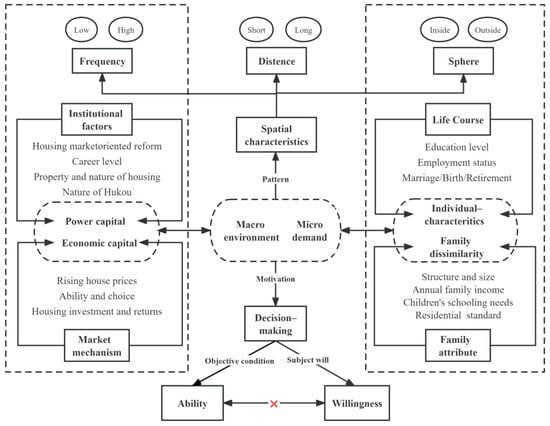
Figure 9.
Modelling of mobility decisions.
Residents exhibit spatial distribution disparities and are in a continuous process of differentiation and evolution, manifesting between different urban internal and external zones, high-frequency versus low-frequency mobility, and mobility over varying distances. This study discerns a convergence in residential and locational choices among residents with similar or proximate social attributes and life courses (Figure 10). For instance, those in the inner circle characterized by high-frequency and short-distance mobility tend to be younger, have simpler family compositions, and are more active in the rental market. Conversely, those in the external circle, exhibiting low-frequency and long-distance mobility, often possess stable incomes, larger family sizes, and balance housing prices with per capita housing area. After mobility, their housing area tends to increase, with an increment rate of 85.29%.
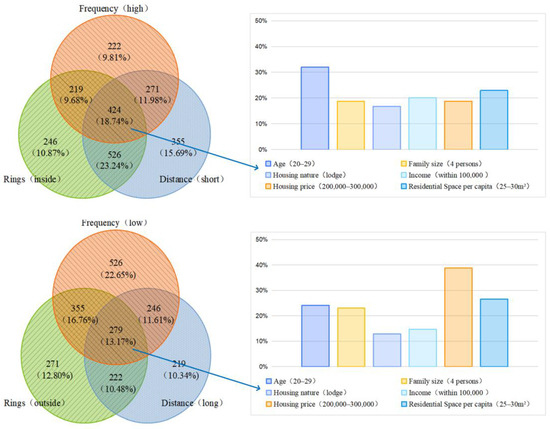
Figure 10.
Attribute differences in typical mobility categories.
5. Conclusions
Residential mobility has consistently served as the foundational force behind urban morphological development and spatial restructuring. Especially against the backdrop of increasing autonomous residential choices, urban issues arising from mobility are becoming increasingly pronounced. This paper, grounded in a retrospective residential mobility survey of 4015 samples from Nanjing, delineates the spatiotemporal characteristics of mobility. Employing a combination of qualitative and quantitative methodologies; utilizing the Mantel Test, we analyzed the relationship between migratory spatial changes and individual socio-demographic attributes. Delving into both the microscopic, individualized housing needs and choices and the macroscopic urbanization and real estate market forces, we draw the following primary conclusions:
(1) Urban internal mobility among Nanjing’s residents is becoming increasingly frequent, with mobility rates concentrating around less than once every five years since the 21st century. Mobility predominantly occurs within the same district, and the quantity of mobility samples decays with increasing mobility distance, conforming to the mobility field formula. Residents’ exhibit varied spatial distributions and are undergoing continual differentiation. Using Venn diagrams, we observed a convergence in residential and locational choices among residents with analogous social attributes and life courses. External, long–distance, low–frequency mobility is most sensitive to family size and per capita housing area, while internal, short–distance, high-frequency mobility predominantly consist of younger residents with simpler family structures and non-Nanjing household registrations.
(2) The spatiotemporal pathways of residential mobility intertwine complexly with microscopic life course indicators, family attributes, and macroscopic housing market and institutional factors. Using Mantel Test analyses, we identified strong associations between mobility strata and microscopic dimensions. Inner-city areas are predominantly occupied by residents with higher education levels and professional standings. Within these strata, there is a trend of “gentrification” in quality educational resource areas marked by a shift towards owning and renting households. Mobility distances only moderately correlate with housing price indices, and the sensitivity of mobility distances to housing prices varies across strata. The housing market reforms have profoundly impacted the mobility frequency across different mobility epochs.
(3) The Mantel test also revealed that, following the marketization reform of the housing sector, particularly post-1998, there was an explosive growth in residential relocation concurrent with the boom in China’s real estate market. The transformation in housing ownership rights significantly impacted the frequency of relocation. For instance, families in the rent-to-rent and rent-to-buy categories migrate more frequently than those in the buy-to-buy category. Simultaneously, a positive correlation was observed between the age of housing and the frequency of relocation, indicating that populations residing in newer housing are more prone to moving.
Overall, using Nanjing, China as a case study and employing extensive data and technical tools, other countries and regions can explore these methodologies. By harnessing data analytics and technological applications, they can attain a better understanding and management of residential mobility, achieving sustainable urban planning and housing policies. For example, this study discovered a significant differentiation between residents of the inner and outer city in Nanjing, resulting in a marked spatial segregation. Moreover, due to the capitalization of educational products, the jiaoyufication of inner-city housing is particularly pronounced. This necessitates government intervention through macro-regulatory measures to optimize the spatial distribution of public rental housing and low-rent housing, aiming to prevent further spatial differentiation and segregation.
Additionally, it is pertinent to further note that the Mantel Test, which analyzes migration characteristics alongside individual socio-economic attributes, can only detect correlations between two or more matrices and cannot ascertain causal relationships. It is also sensitive to outliers and anomalies within the data, necessitating cautious handling of such aberrations. However, in contrast to spatial autocorrelation analysis, which is limited to examining the entire spatial dataset or local spatial autocorrelation around specific locations, the Mantel Test method utilized in this paper can be applied to study correlations between different datasets. Its versatility is substantial, allowing not only for the analysis of spatial data but also for depicting the impact of spatial changes on multidimensional observational outcomes, thus providing a reference for subsequent related research.
Author Contributions
Conceptualization, Weixuan Song; Funding acquisition, Weixuan Song; Investigation, Miao He; Methodology, Ling Ye; Project administration, Weixuan Song; Software, Ling Ye; Visualization, Miao He; Writing—original draft, Ling Ye; Writing—review and editing, Chunhui Liu. All authors have read and agreed to the published version of the manuscript.
Funding
This research was funded by the Category of Strategic Priority Research Program of CAS (grant No. XDA20010101), the National Natural Science Foundation of China (grant Nos. 42271245, 41771234, and 41971211) and The Nanjing Youth Cultural Talent Cultivation Program: Doctoral Workstation for the Research of Cultural Empowerment of Urban Regeneration.
Data Availability Statement
The data in Table 1 of the paper are from public sources. This data can be found here: [https://tjj.nanjing.gov.cn/bmfw/njsj/202105/t20210524_2945571.html (accessed on 1 May 2020)]. Other data are not publicly available due to privacy concerns.
Conflicts of Interest
The authors declare no conflicts of interest.
References
- Lee, E.S. A theory of migration. Demography 1966, 3, 47–57. [Google Scholar] [CrossRef]
- Coulter, R.; van Ham, M. Following People Through Time: An Analysis of Individual Residential Mobility Biographies. Hous. Stud. 2013, 28, 1037–1055. [Google Scholar] [CrossRef]
- Kim, J.H. Residential and job mobility: Interregional variation and their interplay in US metropolitan areas. Urban Stud. 2014, 51, 2863–2879. [Google Scholar] [CrossRef]
- Li, S.-m.; Mao, S.; Du, H. Residential mobility and neighbourhood attachment in Guangzhou, China. Environ. Plan. A Econ. Space 2018, 51, 761–780. [Google Scholar] [CrossRef]
- Hoekstra, J. Housing and the Welfare State in the Netherlands: An Application of Esping-Andersen’s Typology. Hous. Theory Soc. 2003, 20, 58–71. [Google Scholar] [CrossRef]
- Ronald, R.; Doling, J. Shifting East Asian Approaches to Home Ownership and the Housing Welfare Pillar. Int. J. Hous. Policy 2010, 10, 233–254. [Google Scholar] [CrossRef]
- Wang, Y.P.; Murie, A. The New Affordable and Social Housing Provision System in China: Implications for Comparative Housing Studies. Int. J. Hous. Policy 2011, 11, 237–254. [Google Scholar] [CrossRef]
- Zhou, J.; Ronald, R. Housing and Welfare Regimes: Examining the Changing Role of Public Housing in China. Hous. Theory Soc. 2016, 34, 253–276. [Google Scholar] [CrossRef]
- Chan, K.W.; Liu, T.; Yang, Y. Hukou and non-hukou migrations in China: Comparisons and contrasts. Int. J. Popul. Geogr. 1999, 5, 425–448. [Google Scholar] [CrossRef]
- Lin, S.; Wu, F.; Liang, Q.; Li, Z.; Guo, Y. From hometown to the host city? Migrants’ identity transition in urban China. Cities 2022, 122, 103567. [Google Scholar] [CrossRef]
- Huang, Y. The road to homeownership: A longitudinal analysis of tenure transition in urban China (1949–94). Int. J. Urban Reg. Res. 2004, 28, 774–795. [Google Scholar] [CrossRef]
- Xie, Y.; Jin, Y. Household Wealth in China. Chin. Sociol. Rev. 2015, 47, 203–229. [Google Scholar] [CrossRef] [PubMed]
- Halfacree, K.H.; Boyle, P.J. The challenge facing migration research: The case for a biographical approach. Prog. Hum. Geogr. 1993, 17, 333–348. [Google Scholar] [CrossRef] [PubMed]
- Kendig, H.L. Housing Careers, Life Cycle and Residential Mobility: Implications for the Housing Market. Urban Stud. 2016, 21, 271–283. [Google Scholar] [CrossRef]
- Li, S.-M.; Siu, Y.-M. Residential Mobility and Urban Restructuring under Market Transition: A Study of Guangzhou, China. Prof. Geogr. 2010, 53, 219–229. [Google Scholar] [CrossRef]
- Lin, S.; Wu, F.; Wang, Y.; Li, Z. Migrants’ perceived social integration in different housing tenures in urban China. Geoforum 2023, 139, 103693. [Google Scholar] [CrossRef]
- Richmond, A.H. Book Reviews: John Rex and Robert Moore, Race Community and Conflict: A Study of Spark- brook, published for the Institute of Race Relations, London, by Oxford University Press, 1967, pp. XVI + 304. Int. J. Comp. Sociol. 1967, 8, 265–266. [Google Scholar] [CrossRef]
- Yi, C.; Huang, Y. Housing Consumption and Housing Inequality in Chinese Cities during the First Decade of the Twenty-First Century. Hous. Stud. 2014, 29, 291–311. [Google Scholar] [CrossRef]
- Lantz, H.R.; Rossi, P.H. Why Families Move: A Study in the Social Psychology of Urban Residential Mobility. Marriage Fam. Living 1957, 19, 303–304. [Google Scholar] [CrossRef]
- Matherly, W.J.; Hoyt, H. The Structure and Growth of Residential Neighborhoods in American Cities. South. Econ. J. 1940, 7, 268–269. [Google Scholar] [CrossRef]
- Smith, N. Toward a Theory of Gentrification A Back to the City Movement by Capital, not People. J. Am. Plan. Assoc. 1979, 45, 538–548. [Google Scholar] [CrossRef]
- Wolpert, J. Behavioral Aspects of the Decision To Migrate. Pap. Reg. Sci. 1965, 15, 159–169. [Google Scholar] [CrossRef]
- Wolpert, J. Migration as an Adjustment to Environmental Stress. J. Soc. Issues 1966, 22, 92–102. [Google Scholar] [CrossRef]
- Brown, L.A.; Moore, E.G. The Intra-Urban Migration Process: A Perspective. Geogr. Annaler Ser. B Hum. Geogr. 1970, 52, 1–13. [Google Scholar] [CrossRef]
- Morris, T.; Manley, D.; Sabel, C.E. Residential mobility: Towards progress in mobility health research. Prog. Hum. Geogr. 2018, 42, 112–133. [Google Scholar] [CrossRef] [PubMed]
- Clark, W.; Deurloo, M.; Dieleman, F. Residential Mobility and Neighbourhood Outcomes. Hous. Stud. 2006, 21, 323–342. [Google Scholar] [CrossRef]
- Cui, C. Housing career disparities in urban China: A comparison between skilled migrants and locals in Nanjing. Urban Stud. 2018, 57, 546–562. [Google Scholar] [CrossRef]
- Cui, C.; Geertman, S.; Hooimeijer, P. Access to homeownership in urban China: A comparison between skilled migrants and skilled locals in Nanjing. Cities 2016, 50, 188–196. [Google Scholar] [CrossRef]
- Carp, F.M. Symposium the city: A viable environment for the elderly? Phase I. Life-style and location within the city. Gerontologist 1975, 15, 27–34. [Google Scholar] [CrossRef]
- Stouffer, S.A. Intervening Opportunities: A Theory Relating Mobility and Distance. Am. Sociol. Rev. 1940, 5, 845–867. [Google Scholar] [CrossRef]
- Wilson, A.G. A statistical theory of spatial distribution models. Transp. Res. 1967, 1, 253–269. [Google Scholar] [CrossRef]
- Dieleman, F.M. Modelling residential mobility; a review of recent trends in research. J. Hous. Built Environ. 2001, 16, 249–265. [Google Scholar] [CrossRef]
- Bailey, A.J. Population geography: Lifecourse matters. Prog. Hum. Geogr. 2008, 33, 407–418. [Google Scholar] [CrossRef]
- Dorigo, G.; Tobler, W. Push-Pull Migration Laws. Ann. Assoc. Am. Geogr. 2010, 73, 1–17. [Google Scholar] [CrossRef]
- Alonso, W. A Model of the Urban Land Market: Location and Densities of Dwellings and Businesses; University of Pennsylvania: Philadelphia, PA, USA, 1960. [Google Scholar]
- Brown, L.A.; Chung, S.-Y. Spatial segregation, segregation indices and the geographical perspective. Popul. Space Place 2006, 12, 125–143. [Google Scholar] [CrossRef]
- Jia, X.; Lei, J. Residential Mobility of Locals and Migrants in Northwest Urban China. Sustainability 2019, 11, 3507. [Google Scholar] [CrossRef]
- Knox, J.W.; Matthews, R.B.; Wassmann, R. Using a crop/soil simulation model and GIS techniques to assess methane emissions from rice fields in Asia. III. Databases. In Methane Emissions from Major Rice Ecosystems in Asia; Wassmann, R., Lantin, R.S., Neue, H.-U., Eds.; Springer: Dordrecht, The Netherlands, 2000; pp. 179–199. [Google Scholar]
- Somers, K.M.; Jackson, D.A. Putting the Mantel test back together again. Ecology 2022, 103, e3780. [Google Scholar] [CrossRef]
- Zhang, Z.-F.; Pan, J.; Pan, Y.-P.; Li, M. Biogeography, Assembly Patterns, Driving Factors, and Interactions of Archaeal Community in Mangrove Sediments. mSystems 2021, 6, 10-1128. [Google Scholar] [CrossRef]
- Legendre, P.; Fortin, M.-J.; Borcard, D. Should the Mantel test be used in spatial analysis? Methods Ecol. Evol. 2015, 6, 1239–1247. [Google Scholar] [CrossRef]
- Borana, S.L.; Yadav, S.K. Chapter 10—Urban land-use susceptibility and sustainability—Case study. In Water, Land, and Forest Susceptibility and Sustainability; Chatterjee, U., Pradhan, B., Kumar, S., Saha, S., Zakwan, M., Fath, B.D., Fiscus, D., Eds.; Academic Press: Cambridge, MA, USA, 2023; Volume 2, pp. 261–286. [Google Scholar]
- Leduc, A.; Drapeau, P.; Bergeron, Y.; Legendre, P. Study of spatial components of forest cover using partial Mantel tests and path analysis. J. Veg. Sci. 1992, 3, 69–78. [Google Scholar] [CrossRef]
- Dutilleul, P.; Stockwell, J.D.; Frigon, D.; Legendre, P. The Mantel Test versus Pearson’s Correlation Analysis: Assessment of the Differences for Biological and Environmental Studies. J. Agric. Biol. Environ. Stat. 2000, 5, 131–150. [Google Scholar] [CrossRef]
- Stutz, A.J.; Munro, N.D.; Bar-Oz, G. Increasing the resolution of the Broad Spectrum Revolution in the Southern Levantine Epipaleolithic (19–12 ka). J. Hum. Evol. 2009, 56, 294–306. [Google Scholar] [CrossRef] [PubMed]
- Mantel, N. The Detection of Disease Clustering and a Generalized Regression Approach. Cancer Res. 1967, 27, 209–220. [Google Scholar] [PubMed]
- Hägerstraand, T. What About People in Regional Science? Pap. Reg. Sci. 2005, 24, 7–24. [Google Scholar] [CrossRef]
- Wu, Q.; Zhang, X.; Waley, P. Jiaoyufication: When gentrification goes to school in the Chinese inner city. Urban Stud. 2016, 53, 3510–3526. [Google Scholar] [CrossRef]
- Song, W.; Cao, H.; Tu, T.; Song, Z.; Chen, P.; Liu, C. Jiaoyufication as an education-driven gentrification in urban China: A case study of Nanjing. J. Geogr. Sci. 2023, 33, 1095–1112. [Google Scholar] [CrossRef]
- Geng, B.; Bao, H.; Liang, Y. A study of the effect of a high-speed rail station on spatial variations in housing price based on the hedonic model. Habitat Int. 2015, 49, 333–339. [Google Scholar] [CrossRef]
- Fang, Y.; Zhang, Z. Migrant household homeownership outcomes in large Chinese cities—The sustained impact of hukou. Eurasian Geogr. Econ. 2016, 57, 203–227. [Google Scholar] [CrossRef]
- Bernard, A. Levels and patterns of internal migration in Europe: A cohort perspective. Popul. Stud. 2017, 71, 293–311. [Google Scholar] [CrossRef]
- Clark, W.A.V. Race, Class, and Place: Evaluating Mobility Outcomes for African Americans. Urban Aff. Rev. 2007, 42, 295–314. [Google Scholar] [CrossRef]
- Flowerdew, R.; Al-Hamad, A. The relationship between marriage, divorce and migration in a British data set. J. Ethn. Migr. Stud. 2004, 30, 339–351. [Google Scholar] [CrossRef]
- Huang, X.; Dijst, M.; van Weesep, J. Tenure choice in China’s medium-sized cities after hukou reform: A case study of rural–urban migrants’ housing careers in Yangzhou. J. Hous. Built Environ. 2019, 35, 353–373. [Google Scholar] [CrossRef]
- Talen, E.; Anselin, L. Assessing Spatial Equity: An Evaluation of Measures of Accessibility to Public Playgrounds. Environ. Plan. A Econ. Space 1998, 30, 595–613. [Google Scholar] [CrossRef]
- Lee, H.; Myers, D.; Painter, G.; Thunell, J.; Zissimopoulos, J. The role of parental financial assistance in the transition to homeownership by young adults. J. Hous. Econ. 2020, 47, 101597. [Google Scholar] [CrossRef]
- Öst, C.E. Parental Wealth and First-time Homeownership: A Cohort Study of Family Background and Young Adults’ Housing Situation in Sweden. Urban Stud. 2011, 49, 2137–2152. [Google Scholar] [CrossRef]
Disclaimer/Publisher’s Note: The statements, opinions and data contained in all publications are solely those of the individual author(s) and contributor(s) and not of MDPI and/or the editor(s). MDPI and/or the editor(s) disclaim responsibility for any injury to people or property resulting from any ideas, methods, instructions or products referred to in the content. |
© 2024 by the authors. Licensee MDPI, Basel, Switzerland. This article is an open access article distributed under the terms and conditions of the Creative Commons Attribution (CC BY) license (https://creativecommons.org/licenses/by/4.0/).